A
Auto Express
Guest
The hard shoulder is a vital lane that's part of the motorway network across the UK, but it's also one of the most misunderstood lanes. While some hard shoulders are being upgraded with the introduction of smart motorways, turning them into running traffic lanes at peak periods, it's handy to have a refresher about the standard hard shoulder, which is what you'll get here.
The idea of the hard shoulder dates back to the establishment of the motorways back in the 1960s. These new-fangled multi-lane highways were given an additional lane for a number of reasons. If needed, the hard shoulder is a safe refuge out of the traffic flow for broken down vehicles, or can be used by the emergency services to bypass jams to get to the scene of an incident.
• Most reliable cars
Another bonus of the hard shoulder is that it gives extra support to the main carriageway, and the extra width helps water to run away from the other lanes, so the road surface lasts longer before wearing out.
What is the hard shoulder?
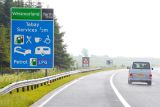
Tebay motorway service station
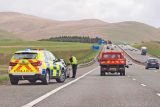
Police on motorway
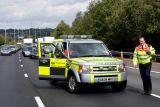
Road safety week, motorway, accident, highways agency
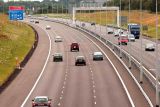
motorway
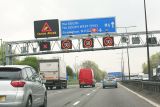
M6 motorway traffic
In the UK, the motorway hard shoulder is defined by a standard set of regulations, although the introduction of smart motorways has thrown some new standards into the mix. In most cases, the motorway will have a hard shoulder along its whole length, although some carriageway widening schemes have seen the shoulder eliminated to create more space for driving lanes. Where there is a hard shoulder, it is set at an industrial standard 3.3-metres wide, so there's enough space for large lorries to pull over without encroaching on lane one.
A solid line, usually painted with white paint that contains reflective material, divides the hard shoulder from the main carriageway. It's also ridged to cause a rumble through the wheels and steering of vehicles that cross it, to help warn drivers that they have strayed too far left. In addition, red cats' eyes are set into the outer edge of the white line as another visual indicator of the shoulder. These are swapped for green ones when a slip road crosses the hard shoulder, indicating where you should leave or join the main carriageway.
When to use a hard shoulder

Tebay motorway service station

Police on motorway

Road safety week, motorway, accident, highways agency

motorway

M6 motorway traffic
Under no circumstance are you allowed to stop on the hard shoulder, or the emergency refuge areas on a smart motorway, apart from in an emergency. Emergencies include when your car suffers a mechanical breakdown, if you get a puncture, if a trailer or any items you are carrying on your car have worked loose, or if you have a medical emergency. You can't stop on the hard shoulder if you want to make or receive a phone call, if you're tired or need to go to the toilet - that's what service stations are for and you should plan your rest stops around them.
In addition, you cannot use the hard shoulder as a driving lane, unless you are told to do so by a police traffic officer or a Highways England patrol. The other exception is in roadworks, where the yellow signs will indicate when a contraflow that moves lane one over to the hard shoulder is in force. Once you come to the end of the contraflow you must move back to lane one.
• How to clean paint scratches off your car
If you are leaving the motorway via a slip road, but there is a tailback on said slip road, you are not allowed to pull over into the hard shoulder to ease traffic flow on the main carriageway. It might seem like a good idea, but you end up covering the road markings, as well as blocking a potential access route for emergency services, and drivers behind you might not be as conscientious and try to push in further up the queue, causing more delays behind.
How to use a hard shoulder

Tebay motorway service station

Police on motorway

Road safety week, motorway, accident, highways agency

motorway

M6 motorway traffic
When you need to stop on the hard shoulder, you should pull over as far to the left as possible and ensure your hazard warning lights are on, especially at night, so that following traffic can see that you are there. Before you get out of the car, it can be useful to turn the steering slightly to the left, so that if the worst should happen and another vehicle collides with your car, it will veer off to the left, rather than back into the carriageway, where it could cause a larger accident.
When you get out of the car, make sure the handbrake is on, and get out via the left-hand doors, away from moving traffic. Find an emergency phone - large orange SOS signs will indicate where the nearest one is - to contact the services to come and rescue you.
If you can, look around to see if there is a motorway marker post nearby. These small white posts have blue and red markings and a number written on them. This number is unique to your location, and makes it easier for emergency services to locate you, as they not only show where you are, but are also marked to let the services know which side of the motorway you're travelling on.
• Tyre pressures and tread depths explained
Once you have left the car, it's advisable to stay back from the road. If there is an armco barrier or concrete walls, then stand behind it. If there's a rising embankment, then move up it a little to get out of harm’s way, but if it's an embankment that drops away from the road, stay level with the road, so that other drivers and the services can see you. If you have one, put on a high-visibility vest to help you to be seen.
Hard shoulder top tips

Tebay motorway service station

Police on motorway

Road safety week, motorway, accident, highways agency

motorway

M6 motorway traffic
Only stop on the hard shoulder in an emergency. Taking a phone call or going to the toilet do not count as emergencies.
How you got any hard shoulder horror stories? Let us know in the comments below...
Continue reading...
The idea of the hard shoulder dates back to the establishment of the motorways back in the 1960s. These new-fangled multi-lane highways were given an additional lane for a number of reasons. If needed, the hard shoulder is a safe refuge out of the traffic flow for broken down vehicles, or can be used by the emergency services to bypass jams to get to the scene of an incident.
• Most reliable cars
Another bonus of the hard shoulder is that it gives extra support to the main carriageway, and the extra width helps water to run away from the other lanes, so the road surface lasts longer before wearing out.
What is the hard shoulder?

Tebay motorway service station

Police on motorway

Road safety week, motorway, accident, highways agency

motorway

M6 motorway traffic
In the UK, the motorway hard shoulder is defined by a standard set of regulations, although the introduction of smart motorways has thrown some new standards into the mix. In most cases, the motorway will have a hard shoulder along its whole length, although some carriageway widening schemes have seen the shoulder eliminated to create more space for driving lanes. Where there is a hard shoulder, it is set at an industrial standard 3.3-metres wide, so there's enough space for large lorries to pull over without encroaching on lane one.
A solid line, usually painted with white paint that contains reflective material, divides the hard shoulder from the main carriageway. It's also ridged to cause a rumble through the wheels and steering of vehicles that cross it, to help warn drivers that they have strayed too far left. In addition, red cats' eyes are set into the outer edge of the white line as another visual indicator of the shoulder. These are swapped for green ones when a slip road crosses the hard shoulder, indicating where you should leave or join the main carriageway.
When to use a hard shoulder

Tebay motorway service station

Police on motorway

Road safety week, motorway, accident, highways agency

motorway

M6 motorway traffic
Under no circumstance are you allowed to stop on the hard shoulder, or the emergency refuge areas on a smart motorway, apart from in an emergency. Emergencies include when your car suffers a mechanical breakdown, if you get a puncture, if a trailer or any items you are carrying on your car have worked loose, or if you have a medical emergency. You can't stop on the hard shoulder if you want to make or receive a phone call, if you're tired or need to go to the toilet - that's what service stations are for and you should plan your rest stops around them.
In addition, you cannot use the hard shoulder as a driving lane, unless you are told to do so by a police traffic officer or a Highways England patrol. The other exception is in roadworks, where the yellow signs will indicate when a contraflow that moves lane one over to the hard shoulder is in force. Once you come to the end of the contraflow you must move back to lane one.
• How to clean paint scratches off your car
If you are leaving the motorway via a slip road, but there is a tailback on said slip road, you are not allowed to pull over into the hard shoulder to ease traffic flow on the main carriageway. It might seem like a good idea, but you end up covering the road markings, as well as blocking a potential access route for emergency services, and drivers behind you might not be as conscientious and try to push in further up the queue, causing more delays behind.
How to use a hard shoulder

Tebay motorway service station

Police on motorway

Road safety week, motorway, accident, highways agency

motorway

M6 motorway traffic
When you need to stop on the hard shoulder, you should pull over as far to the left as possible and ensure your hazard warning lights are on, especially at night, so that following traffic can see that you are there. Before you get out of the car, it can be useful to turn the steering slightly to the left, so that if the worst should happen and another vehicle collides with your car, it will veer off to the left, rather than back into the carriageway, where it could cause a larger accident.
When you get out of the car, make sure the handbrake is on, and get out via the left-hand doors, away from moving traffic. Find an emergency phone - large orange SOS signs will indicate where the nearest one is - to contact the services to come and rescue you.
If you can, look around to see if there is a motorway marker post nearby. These small white posts have blue and red markings and a number written on them. This number is unique to your location, and makes it easier for emergency services to locate you, as they not only show where you are, but are also marked to let the services know which side of the motorway you're travelling on.
• Tyre pressures and tread depths explained
Once you have left the car, it's advisable to stay back from the road. If there is an armco barrier or concrete walls, then stand behind it. If there's a rising embankment, then move up it a little to get out of harm’s way, but if it's an embankment that drops away from the road, stay level with the road, so that other drivers and the services can see you. If you have one, put on a high-visibility vest to help you to be seen.
Hard shoulder top tips

Tebay motorway service station

Police on motorway

Road safety week, motorway, accident, highways agency

motorway

M6 motorway traffic
Only stop on the hard shoulder in an emergency. Taking a phone call or going to the toilet do not count as emergencies.
- 1. Never drive on the hard shoulder unless directed to do so by road signs or a police officer.
- 2. When you stop on a hard shoulder pull over as far to the left as possible and put your hazard lights on.
- 3. Get out of the car and onto the far side of the Armco barrier.
- 4. Find a motorway marker post to confirm your position.
- 5. Find an emergency phone and call for help.
- 6. Wait with your car, staying on the far side of the Armco barrier.
How you got any hard shoulder horror stories? Let us know in the comments below...
Continue reading...
